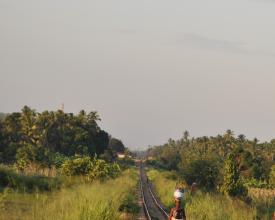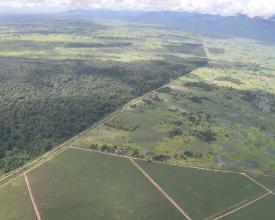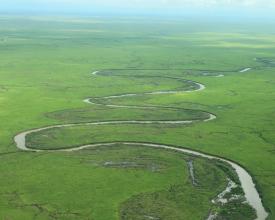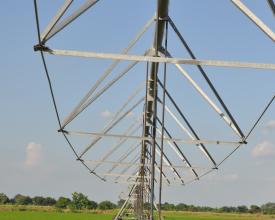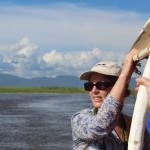
Comprometer a las empresas para impulsar la sostenibilidad de la agricultura africana
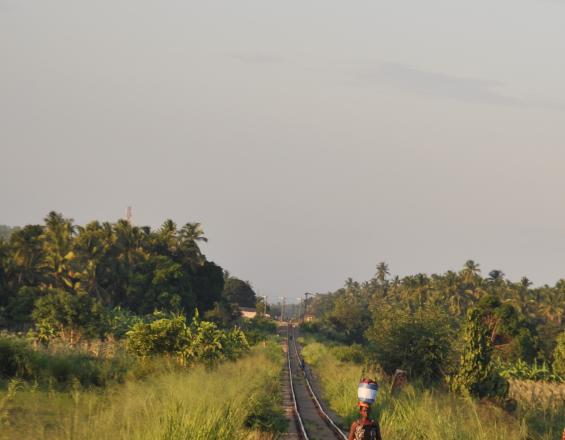
Los corredores de crecimiento son regiones donde se están desarrollando industrias basadas en los recursos naturales, como la agricultura y la minería, para impulsar el crecimiento económico. SUSTAIN (Estrategia de Sostenibilidad e Inclusión para los Corredores de Crecimiento), una iniciativa liderada por la UICN, pretende configurar la inversión y el diseño de estos corredores para que sean sostenibles desde el punto de vista medioambiental y social.
Situado en una vasta llanura aluvial, el distrito tanzano de Kilombero alberga humedales, cascadas y especies emblemáticas de fauna silvestre, como elefantes, hipopótamos, antílopes y leones. Los bosques pluviales de montaña son una fuente de agua vital para los alrededores y su economía. En el marco de SUSTAIN, la African Wildlife Foundation (AWF) colabora con uno de los mayores productores de arroz de Tanzania, los agricultores del valle y las aldeas de montaña de Kilombero para aumentar la productividad agrícola al tiempo que se conservan los bosques, las fuentes de agua y la fauna salvaje a nivel de paisaje coordinado. Uno de los pilares del programa es un sistema de pago por servicios ecosistémicos (PSE).
Contexto
Défis à relever
- La población crece rápidamente. La sobreexplotación de los recursos naturales amenaza los ecosistemas naturales, como la Reserva Natural de Kilombero y el corredor de vida salvaje de Ruipa.
- La población depende en gran medida de la agricultura, principalmente del arroz y el cacao. La dependencia económica y la falta de conocimientos de gestión provocan grandes pérdidas durante la cosecha y la transformación, lo que se traduce en menores ingresos. Los bajos rendimientos hacen necesaria la expansión de la tierra para aumentar la producción, lo que rompe los corredores de vida salvaje, degrada los bosques e invade los cursos de agua. Cuando la agricultura invade los corredores de vida salvaje, aumentan los conflictos entre el hombre y la fauna.
- Lleva tiempo armonizar los intereses de agricultores, pastores, empresas y gobiernos. Cada grupo tiene su propia perspectiva, escala de tiempo y forma de trabajar. La comunicación y la creación de un espacio para el diálogo son fundamentales para formar una visión compartida.
- La aplicación de normas mundiales, como las relativas a la valoración de los ecosistemas, puede ser compleja y requiere conocimientos especializados no siempre fáciles de encontrar a tiempo.
Ubicación
Procesar
Resumen del proceso
La necesidad de un seguimiento y una evaluación continuos, la gestión adaptativa, la transparencia y la rendición de cuentas subyacen y vinculan estos pilares que, juntos, crean un enfoque paisajístico inclusivo de la agricultura sostenible.
El acceso a nuevos mercados y el aumento de los ingresos son fuertes motivaciones para que los agricultores conserven el hábitat y los recursos naturales. Para garantizar que la conservación de la naturaleza se integra en las prácticas agrícolas cotidianas es necesario disponer de documentación adecuada y realizar controles periódicos.
En última instancia, la confianza y la responsabilidad son esenciales para que el sistema de PSE sea eficaz. Una vez que los agricultores demuestren que están mejorando las prácticas de conservación, se les puede dar formación y otras ayudas para mejorar la productividad utilizando medidas compatibles con el medio ambiente.
AWF y sus socios están aprendiendo y compartiendo conjuntamente las mejores prácticas de Kilombero en todo el Corredor Meridional de Crecimiento Agrícola de Tanzania (SAGCOT) y más allá.
Bloques de construcción
Establecer una gobernanza integradora
¿Qué instituciones y políticas se necesitan para fomentar un crecimiento verde integrador? Esta fue la primera y más crítica pregunta abordada por los socios. Juntos evaluaron la gobernanza de los recursos naturales en Kilombero utilizando un marco establecido por la UICN. Utilizaron un enfoque basado en los derechos para mejorar la inclusión social y económica en el distrito, centrándose en las aldeas de la parte baja de Mngeta.
Los planes de uso de la tierra de las aldeas (VLUP, por sus siglas en inglés) se consideran fundamentales para abordar los intereses contrapuestos sobre los recursos y resolver los conflictos. Sin embargo, muchos de los factores que hacen que estos planes sean importantes, como el alto valor de la biodiversidad, la escasez de tierras, los desequilibrios de poder, los intereses contrapuestos y los problemas de rendición de cuentas, también dificultan su elaboración y aplicación equitativa. Parece haber muy poca planificación a nivel de paisaje o entre aldeas, incluso dentro del Marco de Ordenación Territorial del Distrito de Kilombero, recientemente finalizado.
Factores facilitadores
La empresa, KPL, mostró interés por abastecerse en mayor medida de arroz y servicios de molinería procedentes de pequeños agricultores locales y se mostró dispuesta a fomentar prácticas sostenibles.
La creación de asociaciones de usuarios del agua y comités de gestión de cuencas en los que participan los pueblos les está ayudando a apropiarse de la gobernanza del uso del agua. Por ejemplo, se ha formado a la población local en el uso de una herramienta de seguimiento, el Mini Stream Assessment Scoring System (miniSASS), que ayuda a evaluar la salud del río Mchombe e informar sobre ella.
Lección aprendida
La iniciativa SAGCOT --para catalizar inversiones agrícolas responsables e inclusivas en este corredor meridional-- puede exacerbar varios retos, entre ellos los conflictos por la tierra, si no aborda explícitamente las cuestiones de derechos y equidad.
Las evaluaciones sociales y medioambientales y la experiencia adquirida con los planes agrícolas existentes en Kilombero ponen de manifiesto riesgos sustanciales para los derechos e intereses de los más vulnerables, como las mujeres, los pastores y los pequeños propietarios.
Existe una clara necesidad de reforzar la capacidad para mejorar la gobernanza e incorporar un enfoque basado en los derechos mediante la formación continua del personal de las organizaciones socias.
Cartografía del uso del suelo y planificación de escenarios
Utilizando imágenes por satélite de la cobertura y el cambio del uso del suelo y otras herramientas cartográficas, el equipo pudo empezar a identificar dónde se necesita protección o restauración, y dónde podría tener lugar una expansión agrícola sostenible. También generaron escenarios que tenían en cuenta distintos aspectos, como las necesidades de la fauna salvaje, los servicios ecosistémicos y la productividad agrícola, para poder identificar y evaluar sinergias y compensaciones.
Se celebraron reuniones con las distintas partes interesadas que influyen en el cambio de uso del suelo, desde autoridades de distrito y empresas hasta comunidades y conservacionistas, para tratar de garantizar un proceso de planificación participativo y a nivel de paisaje.
Factores facilitadores
Avances tecnológicos como las imágenes por satélite y la calidad de las herramientas cartográficas.
Creación de un espacio para el debate abierto y la disposición de las partes interesadas a escuchar los puntos de vista de los demás.
Lección aprendida
Implicar a todas las partes interesadas es fundamental para negociar y articular objetivos realistas y formular recomendaciones que minimicen los conflictos entre usos del suelo.
Tiene que haber una clara justificación empresarial para invertir en conservación y una voluntad entre las empresas de formar nuevas asociaciones.
Diseñar y aplicar un sistema de incentivos
Uno de los pilares de los esfuerzos de restauración ha sido el diseño y aplicación de un sistema de pago por servicios ecosistémicos (PSE) en la cuenca de Mngeta. Se ayuda a las comunidades que viven aguas arriba a conservar el agua para garantizar un caudal suficiente aguas abajo para los pequeños agricultores, que dependen del cultivo del arroz. Estos agricultores están vinculados a la Kilombero Plantations Company Ltd. (KPL) para acceder a la tecnología. (KPL) para que accedan a tecnología que mejore su productividad y su acceso a los mercados.
Factores facilitadores
AWF reunió a comités de uso de la tierra de las aldeas, asociaciones de pequeños agricultores, asociaciones de usuarios del agua, la Oficina del Agua de la Cuenca de Rufiji, KPL y ONG, como el Grupo de Conservación Forestal de Tanzania, para desarrollar el plan de PSE. Las autoridades locales también participan y apoyan el proceso. La participación de un grupo tan diverso de partes interesadas es fundamental para desarrollar un sistema realista, sostenible y responsable.
La KPL deseaba entablar relaciones con las comunidades de los bosques situados río arriba para proteger las fuentes de agua para la producción de energía y el riego.
Lección aprendida
El objetivo es probar este plan y ampliarlo a las principales cuencas hidrográficas de SAGCOT, pero un posible riesgo es que las comunidades situadas río arriba no reciban suficientes incentivos para reducir la deforestación o detener otras actividades que repercuten en el caudal y la calidad del agua.
Todo indica que este modelo es aplicable a otras cadenas de valor y que hay socios dispuestos a participar.
Impactos
- Restauración de las tierras degradadas y de las fuentes de agua, especialmente en las zonas agrícolas situadas entre las Reservas Forestales Naturales de Kilombero y Udzungwa Scarp.
- Formación de asociaciones de usuarios del agua que capaciten a las comunidades para controlar la gestión de los recursos hídricos locales.
- Restauración con éxito del río Mchombe mediante la regeneración natural y la plantación de árboles a lo largo de las orillas del río por parte de grupos comunitarios como los comités de recursos naturales de las aldeas.
- Mayor concienciación y responsabilidad en la gestión racional de los recursos naturales.
- Mayor concienciación sobre los conflictos entre agricultores y fauna salvaje y reducción de los incidentes gracias a la introducción de medidas como el vallado de colmenas y el cultivo de guindillas para disuadir a los elefantes.
- Desarrollo de un modelo que está demostrando ser escalable y reproducible dentro y fuera de la región.
Beneficiarios
Agricultores, comunidades forestales, Kilombero Plantations Limited (KPL) y otras empresas, fauna salvaje.
Objetivos de Desarrollo Sostenible
Historia
El objetivo de SAGCOT es incorporar a 100.000 pequeños agricultores a la agricultura comercial para crear nuevos puestos de trabajo en los sectores de la agricultura, la transformación y el transporte, y generar unos ingresos de 1.200 millones de dólares. El corredor atraviesa tres paisajes importantes para la conservación y alberga importantes poblaciones de elefantes.
AWF colabora con Kilombero Sugar Company, el mayor productor de azúcar de Tanzania, para proporcionar a los pequeños agricultores de su cadena de suministro técnicas de agricultura climáticamente inteligente y variedades de caña mejoradas, junto con acuerdos sobre prácticas de gestión de la tierra y los recursos hídricos que mantengan la función ecológica y la conectividad en el paisaje en general. La empresa está ampliando las prácticas inteligentes desde el punto de vista climático a través de su programa de productores externos, y considera a SUSTAIN y AWF socios estratégicos en la planificación de sus inversiones actuales y futuras.
Otra asociación ha establecido un sistema de pago por servicios ecosistémicos para apoyar la conservación de la cuenca hidrográfica en la subcuenca de Mngeta. Kilombero Plantations Limited, que necesita una cuenca sana para cultivar arroz, paga a cuatro comunidades situadas aguas arriba de sus plantaciones para que ayuden a restaurar la cuenca degradada.
Estas asociaciones basadas en el mercado han invertido 1 millón de dólares en 40.286 hectáreas de tierra bajo gestión sostenible y se dirigen a más de 33.000 beneficiarios. Su objetivo es demostrar que la agricultura respetuosa con la conservación puede ir más allá de los productos nicho por los que los consumidores están dispuestos a pagar precios más altos. En el caso de cultivos importantes como el arroz y la caña de azúcar, las empresas no pueden repercutir en sus consumidores los costes adicionales de las prácticas sostenibles. Sin embargo, el éxito de la conservación depende de la ampliación de la agricultura respetuosa con el medio ambiente para incluir a los productores de cultivos básicos, que son los principales responsables de la asignación de tierras y recursos.
Las empresas ven la urgencia de proteger los ecosistemas que sustentan la producción agrícola y están colaborando con las comunidades y los expertos técnicos para integrar la conservación en las cadenas de valor de sus productos, una inversión crucial para su propio éxito a largo plazo.
Estas asociaciones público-privadas que conservan la tierra y mejoran los medios de subsistencia están proporcionando un modelo para lograr un crecimiento verde e integrador en todo el SAGCOT.

